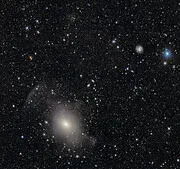In a breathtaking display of celestial fireworks, the Dark Energy Camera has captured an extraordinary image of a “galactic onion,” a shell galaxy known as NGC 3923, spread out over a distance of 150,000 light-years. This gargantuan elliptical galaxy, twice the size of the Milky Way, is a mesmerizing sight, showcasing its symmetrical, concentric layers that have been shaped by the gravitational forces of its turbulent past.
According to astronomers, NGC 3923’s unique structure is the result of a tumultuous merger between two galaxies. As they collided, the larger galaxy’s gravitational field slowly peeled off stars from the smaller galaxy’s disk, causing them to mix with the larger galaxy’s outer halo, forming the characteristic shell-like structures. This process is akin to adding a drop of food color to a bowl of batter, as the stars are gradually stretched out in concentric bands before finally blending with the surrounding material.
The sheer scale of NGC 3923 is awe-inspiring, but it is not the only remarkable feature of this image. In the upper center, a massive galaxy cluster, known as PLCK G287.0+32.9, is exerting its gravitational influence on the cosmos, warping the light coming from distant galaxies and causing it to bend in a phenomenon known as gravitational lensing. This dramatic distortion creates a stunning visual effect, stretching and magnifying the light from these distant galaxies like a cosmic magnifying glass.

Shell Galaxy NGC 3923
The Dark Energy Camera, a ground-based instrument mounted on the Víctor M. Blanco 4-meter Telescope in Chile, has been designed to observe and study the vast expanse of the universe. Originally built for the Dark Energy Survey, it has also been utilized to capture stunning images of dwarf galaxies, merging galaxies, and other celestial wonders. This latest image, showcasing the intricate layering of NGC 3923 and the gravitational lensing effects of the nearby galaxy cluster, is a prime example of the camera’s remarkable capabilities.
As astronomers continue to study the properties of NGC 3923 and its cosmic surroundings, they are gaining valuable insights into the evolution of galaxies and the mysteries of the universe. With its mesmerizing display of shells and its gravitational lensing effects, this image is a testament to the awe-inspiring power of astronomy, as it invites us to explore the vast and intricate world of the cosmos.









































